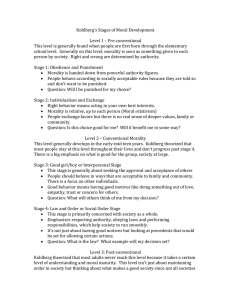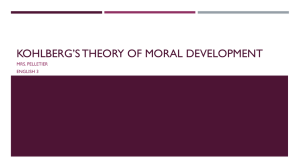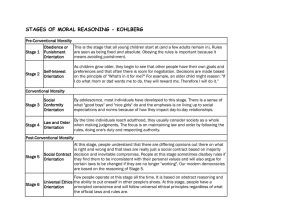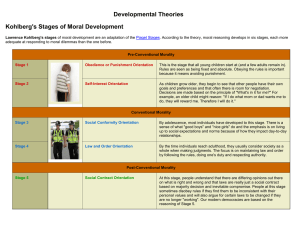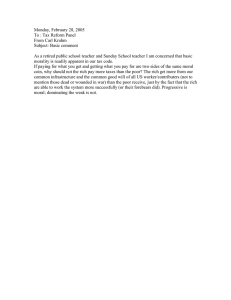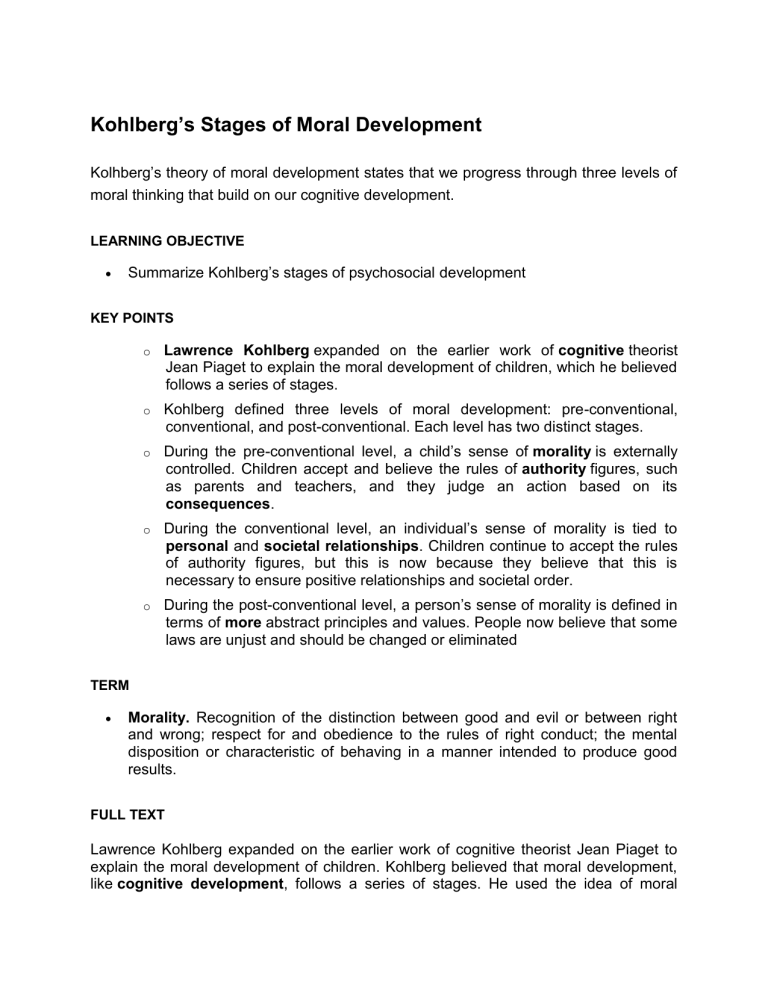
Kohlberg’s Stages of Moral Development Kolhberg’s theory of moral development states that we progress through three levels of moral thinking that build on our cognitive development. LEARNING OBJECTIVE Summarize Kohlberg’s stages of psychosocial development KEY POINTS o Lawrence Kohlberg expanded on the earlier work of cognitive theorist Jean Piaget to explain the moral development of children, which he believed follows a series of stages. o Kohlberg defined three levels of moral development: pre-conventional, conventional, and post-conventional. Each level has two distinct stages. o During the pre-conventional level, a child’s sense of morality is externally controlled. Children accept and believe the rules of authority figures, such as parents and teachers, and they judge an action based on its consequences. o During the conventional level, an individual’s sense of morality is tied to personal and societal relationships. Children continue to accept the rules of authority figures, but this is now because they believe that this is necessary to ensure positive relationships and societal order. o During the post-conventional level, a person’s sense of morality is defined in terms of more abstract principles and values. People now believe that some laws are unjust and should be changed or eliminated TERM Morality. Recognition of the distinction between good and evil or between right and wrong; respect for and obedience to the rules of right conduct; the mental disposition or characteristic of behaving in a manner intended to produce good results. FULL TEXT Lawrence Kohlberg expanded on the earlier work of cognitive theorist Jean Piaget to explain the moral development of children. Kohlberg believed that moral development, like cognitive development, follows a series of stages. He used the idea of moral dilemmas—stories that present conflicting ideas about two moral values—to teach 10 to 16 year-old boys about morality and values. The best known moral dilemma created by Kohlberg is the “Heinz” dilemma, which discusses the idea of obeying the law versus saving a life. Kohlberg emphasized that it is the way an individual reasons about a dilemma that determines positive moral development. After presenting people with various moral dilemmas, Kohlberg reviewed people’s responses and placed them in different stages of moral reasoning. According to Kohlberg, an individual progresses from the capacity for pre-conventional morality (before age 9) to the capacity for conventional morality (early adolescence), and toward attaining post-conventional morality (once Piaget’s idea of formal operational thought is attained), which only a few fully achieve. Each level of morality contains two stages, which provide the basis for moral development in various contexts. Kohlberg’s stages of moral development Kohlberg identified three levels of moral reasoning: pre-conventional, conventional, and post-conventional. Each level is associated with increasingly complex stages of moral development. Level 1: Pre-conventional Throughout the pre-conventional level, a child’s sense of morality is externally controlled. Children accept and believe the rules of authority figures, such as parents and teachers. A child with pre-conventional morality has not yet adopted or internalized society’s conventions regarding what is right or wrong, but instead focuses largely on external consequences that certain actions may bring. Stage 1: Obedience-and-Punishment Orientation Stage 1 focuses on the child’s desire to obey rules and avoid being punished. For example, an action is perceived as morally wrong because the perpetrator is punished; the worse the punishment for the act is, the more “bad” the act is perceived to be. Stage 2: Instrumental Orientation Stage 2 expresses the “what’s in it for me?” position, in which right behavior is defined by whatever the individual believes to be in their best interest. Stage two reasoning shows a limited interest in the needs of others, only to the point where it might further the individual’s own interests. As a result, concern for others is not based on loyalty or intrinsic respect, but rather a “you scratch my back, and I’ll scratch yours” mentality. An example would be when a child is asked by his parents to do a chore. The child asks “what’s in it for me?” and the parents offer the child an incentive by giving him an allowance. Level 2: Conventional Throughout the conventional level, a child’s sense of morality is tied to personal and societal relationships. Children continue to accept the rules of authority figures, but this is now due to their belief that this is necessary to ensure positive relationships and societal order. Adherence to rules and conventions is somewhat rigid during these stages, and a rule’s appropriateness or fairness is seldom questioned. Stage 3: Good Boy, Nice Girl Orientation In stage 3, children want the approval of others and act in ways to avoid disapproval. Emphasis is placed on good behavior and people being “nice” to others. Stage 4: Law-and-Order Orientation In stage 4, the child blindly accepts rules and convention because of their importance in maintaining a functioning society. Rules are seen as being the same for everyone, and obeying rules by doing what one is “supposed” to do is seen as valuable and important. Moral reasoning in stage four is beyond the need for individual approval exhibited in stage three. If one person violates a law, perhaps everyone would—thus there is an obligation and a duty to uphold laws and rules. Most active members of society remain at stage four, where morality is still predominantly dictated by an outside force. Level 3: Post-conventional Throughout the post-conventional level, a person’s sense of morality is defined in terms of more abstract principles and values. People now believe that some laws are unjust and should be changed or eliminated. This level is marked by a growing realization that individuals are separate entities from society and that individuals may disobey rules inconsistent with their own principles. Post-conventional moralists live by their own ethical principles—principles that typically include such basic human rights as life, liberty, and justice—and view rules as useful but changeable mechanisms, rather than absolute dictates that must be obeyed without question. Because post-conventional individuals elevate their own moral evaluation of a situation over social conventions, their behavior, especially at stage six, can sometimes be confused with that of those at the pre-conventional level. Some theorists have speculated that many people may never reach this level of abstract moral reasoning. Stage 5: Social-Contract Orientation In stage 5, the world is viewed as holding different opinions, rights, and values. Such perspectives should be mutually respected as unique to each person or community. Laws are regarded as social contracts rather than rigid edicts. Those that do not promote the general welfare should be changed when necessary to meet the greatest good for the greatest number of people. This is achieved through majority decision and inevitable compromise. Democratic government is theoretically based on stage five reasoning. Stage 6: Universal-Ethical-Principal Orientation In stage 6, moral reasoning is based on abstract reasoning using universal ethical principles. Generally, the chosen principles are abstract rather than concrete and focus on ideas such as equality, dignity, or respect. Laws are valid only insofar as they are grounded in justice, and a commitment to justice carries with it an obligation to disobey unjust laws. People choose the ethical principles they want to follow, and if they violate those principles, they feel guilty. In this way, the individual acts because it is morally right to do so (and not because he or she wants to avoid punishment), it is in their best interest, it is expected, it is legal, or it is previously agreed upon. Although Kohlberg insisted that stage six exists, he found it difficult to identify individuals who consistently operated at that level.
